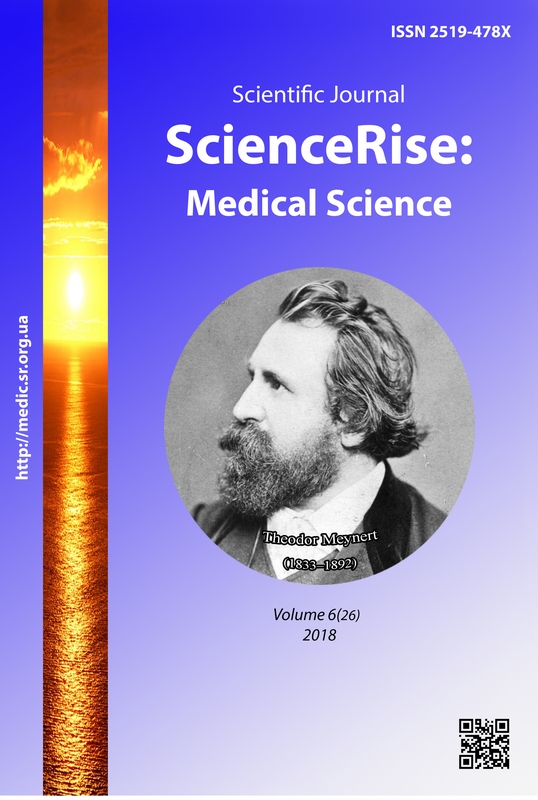Gender and age features of fatty acid composition of blood plasma in mountain dwellers of transcarpathian region
DOI:
https://doi.org/10.15587/2519-4798.2018.143363Keywords:
lipid metabolism, fatty acid spectrum, mountain settlements, overweight, obesityAbstract
The aim of the work is to identify the age and gender characteristics of the fatty acid plasma spectrum in the inhabitants of the mountain settlements of the Transcarpathian region, depending on the body mass index. The object of the study is the lipid and fatty acid plasma spectrum. The subject of the study is the relationship between the state of the fatty acid composition of the plasma and the age and sex of the subjects.
Materials and methods 54 inhabitants of the mountain village Vydrychka of Rakhiv district of Transcarpathian region (average altitude 797 m above sea level) were surveyed. The analysis of the fatty acid plasma spectrum was done, using the method of gas chromatography method, and also lipid spectrum was analyses and evaluation of the body mass index and abdominal circumference was done.
Results: Inhabitants of mountain settlements over 40 years have significantly higher BMI, larger abdominal circumference, higher total cholesterol, higher levels of pentadecanoic, palmitic and stearic, oleic and linoleic acids, higher total polyunsaturated fatty acids (PUFAs), first of all because of a higher level of ώ6 PUFA. Similar deviations were also found among highlanders with overweight and 1st degree obesity, although they have a higher level of not only total but also individual ώ6 PUFAs, in particular, linoleic, Y-linolenic, ώ6-digomo-γ-linolenic, ώ6-arachidonic and ώ6-andrenic PUFA.
Conclusions. People living in mountain settlements over 40 years old, overweight or obese have a higher level of total cholesterol and a more prognostically unfavorable profile of fatty acids due to higher levels of saturated fatty acids (pentadecane, palmitic and stearic fatty acids) and a higher level of total ώ6 PUFA. Favorable lipid and fatty acid profiles were found in persons younger than 40 years old and in subjects with normal weight. Significant differences in the composition of fatty acids among men and women were not found
References
- Karpe, F., Dickmann, J. R., Frayn, K. N. (2011). Fatty Acids, Obesity, and Insulin Resistance: Time for a Reevaluation. Diabetes, 60 (10), 2441–2449. doi: http://doi.org/10.2337/db11-0425
- Rizzo, M., Kotur-Stevuljevic, J., Berneis, K., Spinas, G., Rini, G. B., Jelic-Ivanovic, Z. et. al. (2009). Atherogenic dyslipidemia and oxidative stress: a new look. Translational Research, 153 (5), 217–223. doi: http://doi.org/10.1016/j.trsl.2009.01.008
- Santos, J. L., Perez-Bravo, F., Carrasco, E., Calvillan, M., Albala, C. (2001). Low prevalence of type 2 diabetes despite a high average body mass index in the Aymara natives from Chile. Nutrition, 17 (4), 305–309. doi: http://doi.org/10.1016/s0899-9007(00)00551-7
- Sherpa, L. Y., Deji, Stigum, H., Chongsuvivatwong, V., Luobu, O., Thelle, D. S. et. al. (2011). Lipid Profile and Its Association with Risk Factors for Coronary Heart Disease in the Highlanders of Lhasa, Tibet. High Altitude Medicine & Biology, 12 (1), 57–63. doi: http://doi.org/10.1089/ham.2010.1050
- Vanhala, M., Saltevo, J., Soininen, P., Kautiainen, H., Kangas, A. J., Ala-Korpela, M., Mantyselka, P. (2012). Serum Omega-6 Polyunsaturated Fatty Acids and the Metabolic Syndrome: A Longitudinal Population-based Cohort Study. American Journal of Epidemiology, 176 (3), 253–260. doi: http://doi.org/10.1093/aje/kwr504
- Kutsyn, O. O. (2014). Komorbidnyi perebih ishemichnoi khvoroby sertsia ta tsukrovoho diabetu 2-ho typu u meshkantsiv riznykh vysotnykh rehioniv Zakarpattia. Ukrainskyyi kardiolohichnyi zhurnal, 6, 32–37.
- Bo, S., Ponzo, V., Goitre, I., Fadda, M., Pezzana, A., Beccuti, G. et. al. (2016). Predictive role of the Mediterranean diet on mortality in individuals at low cardiovascular risk: a 12-year follow-up population-based cohort study. Journal of Translational Medicine, 14 (1). doi: http://doi.org/10.1186/s12967-016-0851-7
- Tanaka, S., Fujioka, Y., Tsujino, T., Ishida, T., Hirata, K. (2018). Impact of serum cholesterol esterification rates on the development of diabetes mellitus in a general population. Lipids in Health and Disease, 17 (1). doi: http://doi.org/10.1186/s12944-018-0822-5
- Kitabchi, A. E., Umpierrez, G. E., Miles, J. M., Fisher, J. N. (2009). Hyperglycemic Crises in Adult Patients With Diabetes. Diabetes Care, 32 (7), 1335–1343. doi: http://doi.org/10.2337/dc09-9032
- Adiels, M., Olofsson, S.-O., Taskinen, M.-R., Boren, J. (2008). Overproduction of Very Low-Density Lipoproteins Is the Hallmark of the Dyslipidemia in the Metabolic Syndrome. Arteriosclerosis, Thrombosis, and Vascular Biology, 28 (7), 1225–1236. doi: http://doi.org/10.1161/atvbaha.107.160192
Downloads
Published
How to Cite
Issue
Section
License
Copyright (c) 2018 Antonina Kedyk, Mykola Rishko

This work is licensed under a Creative Commons Attribution 4.0 International License.
Our journal abides by the Creative Commons CC BY copyright rights and permissions for open access journals.
Authors, who are published in this journal, agree to the following conditions:
1. The authors reserve the right to authorship of the work and pass the first publication right of this work to the journal under the terms of a Creative Commons CC BY, which allows others to freely distribute the published research with the obligatory reference to the authors of the original work and the first publication of the work in this journal.
2. The authors have the right to conclude separate supplement agreements that relate to non-exclusive work distribution in the form in which it has been published by the journal (for example, to upload the work to the online storage of the journal or publish it as part of a monograph), provided that the reference to the first publication of the work in this journal is included.









